Deck 23: Wave Properties of Light
Question
Question
Question
Question
Question
Question
Question
Question
Question
Question
Question
Question
Question
Question
Question
Question
Question
Question
Question
Question
Question
Question
Question
Question
Question
Question
Question
Question
Question
Question
Question
Question
Question
Question
Question
Question
Question
Question
Question
Question
Question
Question
Question
Question
Question
Question
Question
Question
Question
Question
Question
Question
Question
Question
Question
Question
Question
Question
Question
Question
Question
Question
Question
Question
Question
Question
Question
Question
Question
Question
Question
Question
Question
Question
Question
Question
Question
Question
Question
Question

Unlock Deck
Sign up to unlock the cards in this deck!
Unlock Deck
Unlock Deck
1/182
Play
Full screen (f)
Deck 23: Wave Properties of Light
1
 An object leaves point A and travels to point B via path a. In region I, the speed is 100 m/s, while in region II, the speed is 71 m/s. How long does it take for the object to go from A to B?
An object leaves point A and travels to point B via path a. In region I, the speed is 100 m/s, while in region II, the speed is 71 m/s. How long does it take for the object to go from A to B?A) 80.0 m/s
B) 60.8 m/s
C) 40.6 m/s
D) 32.4 m/s
E) 26.8 m/s
60.8 m/s
2
A ray of light passes from air into water, striking the surface of the water with an angle of incidence of 45º. Which of the following four quantities change as the light enters the water: 1) wavelength, 2) frequency, 3) speed of propagation, and 4) direction of propagation?
A) 1 and 2 only
B) 2, 3, and 4 only
C) 1, 3, and 4 only
D) 3 and 4 only
E) 1, 2, 3, and 4
A) 1 and 2 only
B) 2, 3, and 4 only
C) 1, 3, and 4 only
D) 3 and 4 only
E) 1, 2, 3, and 4
1, 3, and 4 only
3
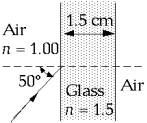 When a ray of light traveling in air is incident at θ = 50º on a plane-parallel slab of glass as illustrated, the light ray
When a ray of light traveling in air is incident at θ = 50º on a plane-parallel slab of glass as illustrated, the light rayA) is 100 percent reflected at the first surface.
B) is 100 percent reflected at the second surface.
C) emerges parallel to the incident ray and is not displaced to one side or the other of the incident ray.
D) is absorbed if the wavelength is greater than 450 nm.
E) is not described by any of these statements.
is not described by any of these statements.
4
 Light travels in a medium of index of refraction n', passes into a medium of index n", where n" > n', and then into air, where nair < n' < n". The ray that correctly shows the light path is
Light travels in a medium of index of refraction n', passes into a medium of index n", where n" > n', and then into air, where nair < n' < n". The ray that correctly shows the light path isA) 1.
B) 2.
C) 3.
D) 4.
E) 5.

Unlock Deck
Unlock for access to all 182 flashcards in this deck.
Unlock Deck
k this deck
5
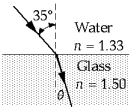 A ray of light strikes a water-glass interface at an angle of incidence of 35º. The angle of refraction is
A ray of light strikes a water-glass interface at an angle of incidence of 35º. The angle of refraction isA) 40.3º.
B) 22.1º.
C) 30.6º.
D) 59.4º.
E) 19.7º.

Unlock Deck
Unlock for access to all 182 flashcards in this deck.
Unlock Deck
k this deck
6
Which of the following statements is true about the speeds of the various colors of light in glass?
A) All colors of light have the same speed in glass.
B) Violet has the highest speed, red the lowest.
C) Red has the highest speed, violet the lowest.
D) Green has the highest speed, red and violet the lowest.
E) Red and violet have the highest speed, green the lowest.
A) All colors of light have the same speed in glass.
B) Violet has the highest speed, red the lowest.
C) Red has the highest speed, violet the lowest.
D) Green has the highest speed, red and violet the lowest.
E) Red and violet have the highest speed, green the lowest.

Unlock Deck
Unlock for access to all 182 flashcards in this deck.
Unlock Deck
k this deck
7
You see a fish in water at an apparent depth of 1.83 m. The actual depth of the fish, if the index of refraction of the water relative to air is 4/3, must be
A) 3.81 cm.
B) 61.0 cm.
C) 1.37 m.
D) 1.83 m.
E) 2.44 m.
A) 3.81 cm.
B) 61.0 cm.
C) 1.37 m.
D) 1.83 m.
E) 2.44 m.

Unlock Deck
Unlock for access to all 182 flashcards in this deck.
Unlock Deck
k this deck
8
You are trying to catch fish by using a spear. You observe a large fish a couple of meters in front of you and a meter below the water surface. In order to hit the fish with your spear you must aim assume that the fish is stationary and does not swim away in fright)
A) directly at the point where you see the fish.
B) slightly above the point where you see the fish.
C) slightly below the point where you see the fish.
D) slightly to the left side of the point where you see the fish.
E) slightly to the right side of the point where you see the fish.
A) directly at the point where you see the fish.
B) slightly above the point where you see the fish.
C) slightly below the point where you see the fish.
D) slightly to the left side of the point where you see the fish.
E) slightly to the right side of the point where you see the fish.

Unlock Deck
Unlock for access to all 182 flashcards in this deck.
Unlock Deck
k this deck
9
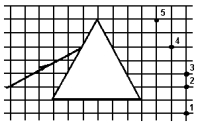 Monochromatic light is incident on the prism at the proper angle for minimum deviation. The emergent ray passes through which point?
Monochromatic light is incident on the prism at the proper angle for minimum deviation. The emergent ray passes through which point?A) 1
B) 2
C) 3
D) 4
E) 5

Unlock Deck
Unlock for access to all 182 flashcards in this deck.
Unlock Deck
k this deck
10
Light traveling in a transparent medium with an index of refraction n1 is incident on a transparent boundary with a second transparent medium with an index n2. Very little light is transmitted into the second medium. Which of the following statements must be true?
A) n1 equals n2
B) n1 is somewhat greater than n2
C) n2 is somewhat greater than n1
D) n2 is much greater than n1
E) Either index of refraction is much greater than the other.
A) n1 equals n2
B) n1 is somewhat greater than n2
C) n2 is somewhat greater than n1
D) n2 is much greater than n1
E) Either index of refraction is much greater than the other.

Unlock Deck
Unlock for access to all 182 flashcards in this deck.
Unlock Deck
k this deck
11
Light is incident on a piece of glass in air at an angle of 37.0º from the normal. If the index of refraction of the glass is 1.50, the angle that the refracted ray makes with the normal is approximately
A) 8.6º.
B) 21.8º.
C) 23.6º.
D) 41.8º.
E) 56.4º.
A) 8.6º.
B) 21.8º.
C) 23.6º.
D) 41.8º.
E) 56.4º.

Unlock Deck
Unlock for access to all 182 flashcards in this deck.
Unlock Deck
k this deck
12
 In the laboratory you used the spectrometer to determine the indices of refraction of various wavelengths of light. The curve that could represent a plot of the index of refraction as a function of the wavelength of the light is
In the laboratory you used the spectrometer to determine the indices of refraction of various wavelengths of light. The curve that could represent a plot of the index of refraction as a function of the wavelength of the light isA) 1.
B) 2.
C) 3.
D) 4.
E) 5.

Unlock Deck
Unlock for access to all 182 flashcards in this deck.
Unlock Deck
k this deck
13
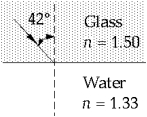 A light ray makes an angle of 42º with the normal to a glass-water surface on the glass side of the surface. The angle θ in the water is
A light ray makes an angle of 42º with the normal to a glass-water surface on the glass side of the surface. The angle θ in the water isA) 42º.
B) 36º.
C) 63º.
D) 49º.
E) 27º.

Unlock Deck
Unlock for access to all 182 flashcards in this deck.
Unlock Deck
k this deck
14
From directly above, you're watching a fish swim 1.83 m beneath the surface of a clear lake n = 1.33). How far beneath the surface does the fish seem to be?
A) 0.914 m
B) 1.37 m
C) 1.83 m
D) 2.44 m
E) 2.93 m
A) 0.914 m
B) 1.37 m
C) 1.83 m
D) 2.44 m
E) 2.93 m

Unlock Deck
Unlock for access to all 182 flashcards in this deck.
Unlock Deck
k this deck
15
A light wave traveling at speed v1 in medium 1 passes into medium 2 where its speed is v2. By which of the following equations is the frequency f1 of the wave in medium 1 related to its frequency f2 in medium 2? θ1 and θ2 are the angles of incidence and refraction.)
A) f1 sin θ1 = f2 sin θ2
B) f1v2 = f2v1
C) f1 = f2
D) f1v1 = f2v2
E) f1 sin θ2 = f2 sin θ1
A) f1 sin θ1 = f2 sin θ2
B) f1v2 = f2v1
C) f1 = f2
D) f1v1 = f2v2
E) f1 sin θ2 = f2 sin θ1

Unlock Deck
Unlock for access to all 182 flashcards in this deck.
Unlock Deck
k this deck
16
The speed of yellow sodium light in a certain liquid is 1.92 × 108 m/s. With respect to air, the index of refraction of this liquid for sodium light is approximately
A) 1.92.
B) 1.56.
C) 1.23.
D) 0.64.
E) 1.33.
A) 1.92.
B) 1.56.
C) 1.23.
D) 0.64.
E) 1.33.

Unlock Deck
Unlock for access to all 182 flashcards in this deck.
Unlock Deck
k this deck
17
 The light ray that passes through the prism and emerges at the angle of minimum deviation for that color is
The light ray that passes through the prism and emerges at the angle of minimum deviation for that color isA) red.
B) yellow.
C) green.
D) blue.
E) violet.

Unlock Deck
Unlock for access to all 182 flashcards in this deck.
Unlock Deck
k this deck
18
As light passes from one medium into another, the angle of refraction is _____ in the medium with the _____ index of refraction and _____ speed of light.
A) smaller; larger; lower
B) smaller; larger; higher
C) larger; smaller; lower
D) larger; larger; lower
E) smaller; smaller; higher
A) smaller; larger; lower
B) smaller; larger; higher
C) larger; smaller; lower
D) larger; larger; lower
E) smaller; smaller; higher

Unlock Deck
Unlock for access to all 182 flashcards in this deck.
Unlock Deck
k this deck
19
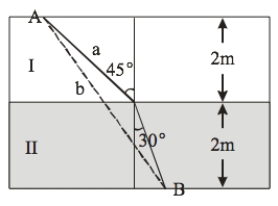 An object leaves point A and travels in a straight line to point B via path b. In region I, the speed is 100 m/s, while in region II, the speed is 71 m/s. How long does it take for the object to go from A to B?
An object leaves point A and travels in a straight line to point B via path b. In region I, the speed is 100 m/s, while in region II, the speed is 71 m/s. How long does it take for the object to go from A to B?A) 82.0 m/s
B) 70.8 m/s
C) 61.3 m/s
D) 34.3 m/s
E) 27.7 m/s

Unlock Deck
Unlock for access to all 182 flashcards in this deck.
Unlock Deck
k this deck
20
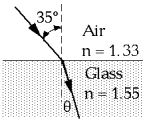 A ray of light strikes a slab of glass at an angle of incidence of 35º. The angle of refraction in the glass is
A ray of light strikes a slab of glass at an angle of incidence of 35º. The angle of refraction in the glass isA) 22º.
B) 63º.
C) 27º.
D) 90º.
E) None of these is correct.

Unlock Deck
Unlock for access to all 182 flashcards in this deck.
Unlock Deck
k this deck
21
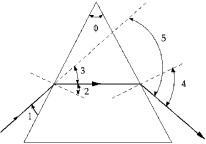 The index of refraction is related to the prism angle and the angle of minimum deviation by n = sin ½d + f)/sin ½f
The index of refraction is related to the prism angle and the angle of minimum deviation by n = sin ½d + f)/sin ½fThe angle of minimum deviation in the figure is angle
A) 1.
B) 2.
C) 3.
D) 4.
E) 5.

Unlock Deck
Unlock for access to all 182 flashcards in this deck.
Unlock Deck
k this deck
22
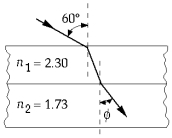 A ray of monochromatic light in air falls on the upper surface of two parallel-sided slabs of transparent material, as shown in the diagram. The angle of refraction φ in the lower slab is approximately
A ray of monochromatic light in air falls on the upper surface of two parallel-sided slabs of transparent material, as shown in the diagram. The angle of refraction φ in the lower slab is approximatelyA) 22º.
B) 30º.
C) 37º.
D) 53º.
E) 60º.

Unlock Deck
Unlock for access to all 182 flashcards in this deck.
Unlock Deck
k this deck
23
A light wave in air strikes a glass plate 1 cm thick at an angle of incidence of 50.0º. If the index of refraction of the glass is 1.50 for this light, the actual path length of the light through the glass is approximately
A) 0.51 cm.
B) 1.16 cm.
C) 1.50 cm.
D) 2.11 cm.
E) 7.66 cm.
A) 0.51 cm.
B) 1.16 cm.
C) 1.50 cm.
D) 2.11 cm.
E) 7.66 cm.

Unlock Deck
Unlock for access to all 182 flashcards in this deck.
Unlock Deck
k this deck
24
A small beam of monochromatic light in air is incident on a large plate of glass with plane-parallel sides at an angle of 30º. The index of refraction of the glass plate for this wavelength is 1.50. The angle of emergence of the light on the far side of the plate is approximately
A) 30º.
B) 45º.
C) 20º.
D) the angle whose sine is 1/3.
E) 60º.
A) 30º.
B) 45º.
C) 20º.
D) the angle whose sine is 1/3.
E) 60º.

Unlock Deck
Unlock for access to all 182 flashcards in this deck.
Unlock Deck
k this deck
25
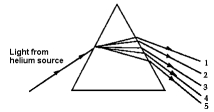 The light ray that passes through the prism and emerges at the angle of minimum deviation for that ray is
The light ray that passes through the prism and emerges at the angle of minimum deviation for that ray isA) 1.
B) 2.
C) 3.
D) 4.
E) 5.

Unlock Deck
Unlock for access to all 182 flashcards in this deck.
Unlock Deck
k this deck
26
 An air prism is immersed in water. A ray of monochromatic light strikes one face as shown. The emerging ray is
An air prism is immersed in water. A ray of monochromatic light strikes one face as shown. The emerging ray isA) 1.
B) 2.
C) 3.
D) 4.
E) 5.

Unlock Deck
Unlock for access to all 182 flashcards in this deck.
Unlock Deck
k this deck
27
The principle of superposition states:
A) The effect observed at each point of a wave made up of two or more waves is the sum of the effects that the individual waves would produce at that point.
B) Huygens' wavelets cannot be allowed to extend across regions where the phase velocity of the wave changes abruptly.
C) Sources of radiation whose phase angles are maintained at constant differences are said to be coherent.
D) A characteristic phenomenon of wave propagation is the tendency of a wave to expand around and behind any obstacles it chances to encounter.
E) A good source of waves at a particular frequency is a good detector of waves at the same frequency.
A) The effect observed at each point of a wave made up of two or more waves is the sum of the effects that the individual waves would produce at that point.
B) Huygens' wavelets cannot be allowed to extend across regions where the phase velocity of the wave changes abruptly.
C) Sources of radiation whose phase angles are maintained at constant differences are said to be coherent.
D) A characteristic phenomenon of wave propagation is the tendency of a wave to expand around and behind any obstacles it chances to encounter.
E) A good source of waves at a particular frequency is a good detector of waves at the same frequency.

Unlock Deck
Unlock for access to all 182 flashcards in this deck.
Unlock Deck
k this deck
28
77 cm. If the refractive index of the liquid is 1.33 at the top and increases uniformly to the bottom, then what is the refractive index at the bottom of the liquid?
A) 1.96
B) 2.95
C) 1.48
D) 1.62
E) None of these is correct.
A) 1.96
B) 2.95
C) 1.48
D) 1.62
E) None of these is correct.

Unlock Deck
Unlock for access to all 182 flashcards in this deck.
Unlock Deck
k this deck
29
An "X" is marked on the bottom of a glass container. A microscope is adjusted so that it is focused on the "X." A liquid is now poured into the glass to a depth of 6.00 cm. If the microscope has to be backed up by a distance of 1.50 cm to refocus on the "X," then calculate the refractive index of the liquid.
A) 1.25
B) 4.00
C) 1.33
D) 0.75
E) 3.00
A) 1.25
B) 4.00
C) 1.33
D) 0.75
E) 3.00

Unlock Deck
Unlock for access to all 182 flashcards in this deck.
Unlock Deck
k this deck
30
The wavelength of green light in air is 500 nm. The wavelength of this light in glass of index of refraction 1.60 is approximately
A) 313 nm.
B) 500 nm.
C) 750 nm.
D) 800 nm.
E) 427 nm.
A) 313 nm.
B) 500 nm.
C) 750 nm.
D) 800 nm.
E) 427 nm.

Unlock Deck
Unlock for access to all 182 flashcards in this deck.
Unlock Deck
k this deck
31
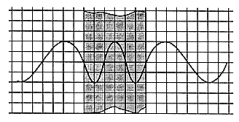 The figure shows the wavelength of light that is normally incident on and transmitted through a refractive medium. The index of refraction of this medium is
The figure shows the wavelength of light that is normally incident on and transmitted through a refractive medium. The index of refraction of this medium isA) 1.0.
B) 1.5.
C) 2.0.
D) 0.67.
E) 3.0.

Unlock Deck
Unlock for access to all 182 flashcards in this deck.
Unlock Deck
k this deck
32
The minimum angle of deviation produced by a glass prism n = 1.70 for the light used) whose apex angle is 45º is approximately
A) 32º.
B) 36º.
C) 26º.
D) 18º.
E) 45º.
A) 32º.
B) 36º.
C) 26º.
D) 18º.
E) 45º.

Unlock Deck
Unlock for access to all 182 flashcards in this deck.
Unlock Deck
k this deck
33
A light wave traveling in air impinges on an amber plate at an angle of incidence of 60º. If the angle of refraction is 34º, the velocity of light in amber must be approximately
A) 0.52 × 108 m/s.
B) 4.64 × 108 m/s.
C) 1.86 × 103 m/s.
D) 2.09 × 108 m/s.
E) 4.64 × 1010 m/s.
A) 0.52 × 108 m/s.
B) 4.64 × 108 m/s.
C) 1.86 × 103 m/s.
D) 2.09 × 108 m/s.
E) 4.64 × 1010 m/s.

Unlock Deck
Unlock for access to all 182 flashcards in this deck.
Unlock Deck
k this deck
34
You shine light of frequency 4.00 × 1014 Hz through a glass plate whose index of refraction for this light is 1.50. The wavelength of this light in the glass is approximately
A) 500 nm.
B) 110 nm.
C) 800 nm.
D) 425 nm.
E) 380 nm.
A) 500 nm.
B) 110 nm.
C) 800 nm.
D) 425 nm.
E) 380 nm.

Unlock Deck
Unlock for access to all 182 flashcards in this deck.
Unlock Deck
k this deck
35
 The rays in the figure are reflected and refracted at the front and back surfaces of the glass. Which of the following is true of these rays?
The rays in the figure are reflected and refracted at the front and back surfaces of the glass. Which of the following is true of these rays?A) < 1 = < 2 = < 3 = < 4
B) < 1 = < 2; < 3 = < 4; but < 1 ≠ < 3
C) < 1 = < 2 = < 3; but < 4 ≠ < 1
D) < 1 = < 4; but < 2 ≠ < 4
E) < 1 ≠ < 2 ≠ < 3 ≠ < 4

Unlock Deck
Unlock for access to all 182 flashcards in this deck.
Unlock Deck
k this deck
36
Huygens' theory for the construction of wavefronts states that
A) the angle of incidence is always less than the angle of refraction.
B) the time required for light to travel from one point to another is either a maximum or minimum.
C) only parallel light produces interference and diffraction.
D) each point on a wavefront is itself the source of a secondary spherical wave.
E) all wavefronts are spherical.
A) the angle of incidence is always less than the angle of refraction.
B) the time required for light to travel from one point to another is either a maximum or minimum.
C) only parallel light produces interference and diffraction.
D) each point on a wavefront is itself the source of a secondary spherical wave.
E) all wavefronts are spherical.

Unlock Deck
Unlock for access to all 182 flashcards in this deck.
Unlock Deck
k this deck
37
"To find the value of the resultant displacement for overlapping waves at any point at a particular instant, it is only necessary to add the values of the displacements for the individual waves." This is a statement of
A) Huygens' principle.
B) the principle of superposition.
C) Bernoulli's principle.
D) the principle of dispersion.
E) Newton's theory of light.
A) Huygens' principle.
B) the principle of superposition.
C) Bernoulli's principle.
D) the principle of dispersion.
E) Newton's theory of light.

Unlock Deck
Unlock for access to all 182 flashcards in this deck.
Unlock Deck
k this deck
38
Two clear but non-mixing liquids each of depth 15 cm are placed together in a glass container. The liquids have refractive indices of 1.75 and 1.33. What is the apparent depth of the combination when viewed from above?
A) 19.8 cm
B) 23.1 cm
C) 17.7 cm
D) 9.9 cm
E) None of these is correct.
A) 19.8 cm
B) 23.1 cm
C) 17.7 cm
D) 9.9 cm
E) None of these is correct.

Unlock Deck
Unlock for access to all 182 flashcards in this deck.
Unlock Deck
k this deck
39
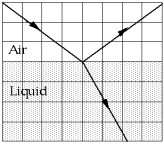 A ray of light is shown reflected and refracted at the surface of a liquid. From the diagram you can determine that the speed of light in this liquid is approximately
A ray of light is shown reflected and refracted at the surface of a liquid. From the diagram you can determine that the speed of light in this liquid is approximatelyA) 1.83 × 108 m/s.
B) 2.24 × 108 m/s.
C) 3.00 × 108 m/s.
D) 4.02 × 108 m/s.
E) 2.50 × 108 m/s.

Unlock Deck
Unlock for access to all 182 flashcards in this deck.
Unlock Deck
k this deck
40
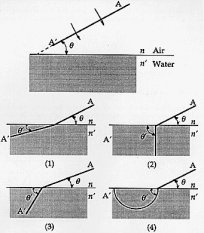 A plane wavefront of light AA') approaches an air-water interface as shown, n < n'. The refracted wave is best represented by
A plane wavefront of light AA') approaches an air-water interface as shown, n < n'. The refracted wave is best represented byA) 1).
B) 2).
C) 3).
D) 4).
E) None of these is correct. There is no refraction because θ is less than the angle of total internal reflection.

Unlock Deck
Unlock for access to all 182 flashcards in this deck.
Unlock Deck
k this deck
41
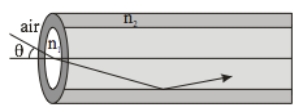 A fiber optic is made by cladding a thin fiber core of refractive index n1 = 1.45 with a material of refractive index n2 = 1.38. What is the maximum incident angle, Ɵ, so that the light ray is totally internally reflected inside the fiber?
A fiber optic is made by cladding a thin fiber core of refractive index n1 = 1.45 with a material of refractive index n2 = 1.38. What is the maximum incident angle, Ɵ, so that the light ray is totally internally reflected inside the fiber?A) 24.1º
B) 26.4º
C) 28.2º
D) 30.3º
E) 32.7º

Unlock Deck
Unlock for access to all 182 flashcards in this deck.
Unlock Deck
k this deck
42
A helium-neon laser emits light of wavelength 632.8 nm and has a power output of 1.5 mW. How many photons are emitted per second by this laser?
A) 1.34 × 1014
B) 2.56 × 1015
C) 3.09 × 1015
D) 4.22 × 1015
E) 4.78 × 1015
A) 1.34 × 1014
B) 2.56 × 1015
C) 3.09 × 1015
D) 4.22 × 1015
E) 4.78 × 1015

Unlock Deck
Unlock for access to all 182 flashcards in this deck.
Unlock Deck
k this deck
43
 A ray of light traveling in air enters the end of a rectangular block of a material that has an index of refraction n = 1.35. The largest value of the angle θ for which total internal reflection occurs at the upper surface of the material is approximately
A ray of light traveling in air enters the end of a rectangular block of a material that has an index of refraction n = 1.35. The largest value of the angle θ for which total internal reflection occurs at the upper surface of the material is approximatelyA) 75º.
B) 48º.
C) 56º.
D) 78º.
E) None of these is correct.

Unlock Deck
Unlock for access to all 182 flashcards in this deck.
Unlock Deck
k this deck
44
Light that has been traveling in a medium with an index of refraction n2 is incident on the boundary surface of another medium with an index of refraction n1. Given a sufficient angle of incidence, which of the following conditions must be satisfied for total internal reflection to occur?
A) n1 < n2
B) n1 > n2
C) n1 = n2
D) Any of these may be correct.
E) None of these is correct.
A) n1 < n2
B) n1 > n2
C) n1 = n2
D) Any of these may be correct.
E) None of these is correct.

Unlock Deck
Unlock for access to all 182 flashcards in this deck.
Unlock Deck
k this deck
45
The wavelength of light that has a photon energy of 4.25 eV is
A) 292 nm.
B) 973 nm.
C) 706 nm.
D) 1559 nm.
E) None of these is correct.
A) 292 nm.
B) 973 nm.
C) 706 nm.
D) 1559 nm.
E) None of these is correct.

Unlock Deck
Unlock for access to all 182 flashcards in this deck.
Unlock Deck
k this deck
46
The critical angle for light rays passing from flint glass n = 1.70) into air is about
A) 3.4º.
B) 36º.
C) 44º.
D) 54º.
E) 90º.
A) 3.4º.
B) 36º.
C) 44º.
D) 54º.
E) 90º.

Unlock Deck
Unlock for access to all 182 flashcards in this deck.
Unlock Deck
k this deck
47
 A light ray traveling in glass strikes a glass-water surface. At angles greater than θC the light ray is totally internally reflected. The value of θC is
A light ray traveling in glass strikes a glass-water surface. At angles greater than θC the light ray is totally internally reflected. The value of θC isA) 15º.
B) 31º.
C) 45º.
D) 23º.
E) None of these is correct.

Unlock Deck
Unlock for access to all 182 flashcards in this deck.
Unlock Deck
k this deck
48
A helium-neon laser emits light of wavelength 632.8 nm and has a power output of 3 mW. How many photons are emitted per second by this laser?
A) 9.55 × 1014
B) 9.55 × 1015
C) 8.24 × 1015
D) 6.53 × 1015
E) 4.78 × 1015
A) 9.55 × 1014
B) 9.55 × 1015
C) 8.24 × 1015
D) 6.53 × 1015
E) 4.78 × 1015

Unlock Deck
Unlock for access to all 182 flashcards in this deck.
Unlock Deck
k this deck
49
 For the prism immersed in water n = 1.33), the minimum index of refraction that will produce total reflection of the indicated ray is approximately
For the prism immersed in water n = 1.33), the minimum index of refraction that will produce total reflection of the indicated ray is approximatelyA) 0.94.
B) 1.28.
C) 1.50.
D) 1.65.
E) 1.88.

Unlock Deck
Unlock for access to all 182 flashcards in this deck.
Unlock Deck
k this deck
50
A glass block with index of refraction 1.50 is immersed in water whose index of refraction is 1.33. The critical angle at the glass-water interface is
A) 6.5º.
B) 41.9º.
C) 48.8º.
D) 56.3º.
E) 62.5º.
A) 6.5º.
B) 41.9º.
C) 48.8º.
D) 56.3º.
E) 62.5º.

Unlock Deck
Unlock for access to all 182 flashcards in this deck.
Unlock Deck
k this deck
51
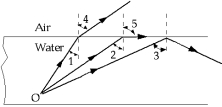 Light from an underwater source at O impinges upon a water-air interface. The critical angle is
Light from an underwater source at O impinges upon a water-air interface. The critical angle isA) 1.
B) 2.
C) 3.
D) 4.
E) 5.

Unlock Deck
Unlock for access to all 182 flashcards in this deck.
Unlock Deck
k this deck
52
 The light ray in the figure is incident on a glass-air surface. The index of refraction of the glass is 1.74. The approximate critical angle for total internal reflection is
The light ray in the figure is incident on a glass-air surface. The index of refraction of the glass is 1.74. The approximate critical angle for total internal reflection isA) 48º.
B) 35º.
C) 30º.
D) 22º.
E) None of these is correct.

Unlock Deck
Unlock for access to all 182 flashcards in this deck.
Unlock Deck
k this deck
53
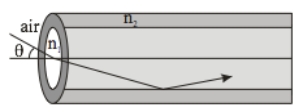 A fiber optic is made by cladding a thin fiber core of refractive index n1 = 1.45 with a material of refractive index n2 = 1.38. What is the critical angle, Ɵc, at the core-cladding interface?
A fiber optic is made by cladding a thin fiber core of refractive index n1 = 1.45 with a material of refractive index n2 = 1.38. What is the critical angle, Ɵc, at the core-cladding interface?A) 44º
B) 46º
C) 55º
D) 72º
E) None of these is correct.

Unlock Deck
Unlock for access to all 182 flashcards in this deck.
Unlock Deck
k this deck
54
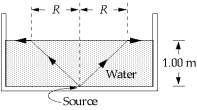 You place a point source of light at the bottom of a pool of water 1.00 m deep. The source emits rays upward in all directions. You notice that a circle of light is formed by the rays that are refracted into the air and that the rays outside of this circle are reflected back into the water. The index of refraction of water is 1.33. The radius R of the circle at the surface of the water is approximately
You place a point source of light at the bottom of a pool of water 1.00 m deep. The source emits rays upward in all directions. You notice that a circle of light is formed by the rays that are refracted into the air and that the rays outside of this circle are reflected back into the water. The index of refraction of water is 1.33. The radius R of the circle at the surface of the water is approximatelyA) 0.75 m.
B) 1.00 m.
C) 1.13 m.
D) 1.33 m.
E) infinite.

Unlock Deck
Unlock for access to all 182 flashcards in this deck.
Unlock Deck
k this deck
55
 The prism totally reflects some wavelengths of light as shown, but other wavelengths pass through. The index of refraction of this prism for the longest wavelengths that are totally reflected is approximately
The prism totally reflects some wavelengths of light as shown, but other wavelengths pass through. The index of refraction of this prism for the longest wavelengths that are totally reflected is approximatelyA) 1.50.
B) 1.53.
C) 1.46.
D) 1.41.
E) 1.59.

Unlock Deck
Unlock for access to all 182 flashcards in this deck.
Unlock Deck
k this deck
56
A light wave is like a sound wave in that both
A) are longitudinal waves.
B) are means of transmitting energy.
C) are transverse waves.
D) require a material medium for propagation.
E) have the same velocity in air.
A) are longitudinal waves.
B) are means of transmitting energy.
C) are transverse waves.
D) require a material medium for propagation.
E) have the same velocity in air.

Unlock Deck
Unlock for access to all 182 flashcards in this deck.
Unlock Deck
k this deck
57
The energy of an electromagnetic wave that is in the red region of the visible spectrum is approximately
A) 1 eV.
B) 2 eV.
C) 3 eV.
D) 4 eV.
E) 5 eV.
A) 1 eV.
B) 2 eV.
C) 3 eV.
D) 4 eV.
E) 5 eV.

Unlock Deck
Unlock for access to all 182 flashcards in this deck.
Unlock Deck
k this deck
58
If the refractive index of glass is 1.5 and the refractive index of a particular liquid is 1.38, then calculate the value for the critical angle of total internal reflection at the liquid-glass interface.
A) 23.1°
B) 66.9°
C) 82.8°
D) 42.6°
E) None of these is correct.
A) 23.1°
B) 66.9°
C) 82.8°
D) 42.6°
E) None of these is correct.

Unlock Deck
Unlock for access to all 182 flashcards in this deck.
Unlock Deck
k this deck
59
The photon energy for light of wavelength 500 nm is approximately
A) 1.77 eV.
B) 3.10 eV.
C) 6.20 eV.
D) 2.48 eV.
E) 5.46 eV.
A) 1.77 eV.
B) 3.10 eV.
C) 6.20 eV.
D) 2.48 eV.
E) 5.46 eV.

Unlock Deck
Unlock for access to all 182 flashcards in this deck.
Unlock Deck
k this deck
60
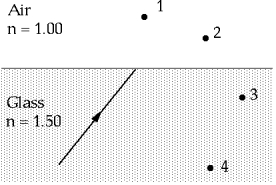 A ray of light in glass is incident on a glass-air interface as shown. You would expect the ray to pass through
A ray of light in glass is incident on a glass-air interface as shown. You would expect the ray to pass throughA) point 1 only.
B) point 3 only.
C) point 4 only.
D) points 2 or 4.
E) points 1 or 4.

Unlock Deck
Unlock for access to all 182 flashcards in this deck.
Unlock Deck
k this deck
61
If you look at a dot on a piece of paper through a calcite crystal lying on the paper, you will see two images of the dot, one of which appears to be nearer to you than the other. From this evidence you can conclude that
A) the beams from both images are polarized.
B) calcite has different indices of refraction for the two beams.
C) there is interference between the two beams.
D) the calcite has increased the resolving power of your eye.
E) the appearance is due to diffraction.
A) the beams from both images are polarized.
B) calcite has different indices of refraction for the two beams.
C) there is interference between the two beams.
D) the calcite has increased the resolving power of your eye.
E) the appearance is due to diffraction.

Unlock Deck
Unlock for access to all 182 flashcards in this deck.
Unlock Deck
k this deck
62
Light is reflected from the surface of a lake n = 1.33). What is the angle of incidence for which the reflected light is 100 percent polarized?
A) 53º
B) 49º
C) 45º
D) 41º
E) 37º
A) 53º
B) 49º
C) 45º
D) 41º
E) 37º

Unlock Deck
Unlock for access to all 182 flashcards in this deck.
Unlock Deck
k this deck
63
A 60° prism has a refractive index of 1.52. Calculate the angle of incidence for the initial light ray that is then refracted inside the prism and just undergoes total internal reflection at the opposite face of the prism.
A) 41.1°
B) 18.9°
C) 29.4°
D) 30.6°
E) 60.6°
A) 41.1°
B) 18.9°
C) 29.4°
D) 30.6°
E) 60.6°

Unlock Deck
Unlock for access to all 182 flashcards in this deck.
Unlock Deck
k this deck
64
The index of refraction of plate glass is 1.50. The polarizing angle for light incident from air is
A) 8.6º.
B) 33.7º.
C) 56.3º.
D) 81.5º.
E) 90º.
A) 8.6º.
B) 33.7º.
C) 56.3º.
D) 81.5º.
E) 90º.

Unlock Deck
Unlock for access to all 182 flashcards in this deck.
Unlock Deck
k this deck
65
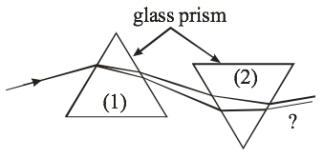 White light is incident on a prism from the left. After it passes through the first prism, a color spectrum of light is observed. The spectrum is then passed through a second prism, which is inverted compared to the first prism. The color light that exits from the second prism
White light is incident on a prism from the left. After it passes through the first prism, a color spectrum of light is observed. The spectrum is then passed through a second prism, which is inverted compared to the first prism. The color light that exits from the second prismA) is also a color spectrum and more spread out.
B) is also a color spectrum but less spread out.
C) is white in color.
D) has more colors than the first spectrum.
E) has fewer colors than the first spectrum.

Unlock Deck
Unlock for access to all 182 flashcards in this deck.
Unlock Deck
k this deck
66
Light is an electromagnetic wave. When visible light is plane polarized,
A) the electric-field vector is parallel to the magnetic-field vector.
B) the electric-field vector is parallel to the direction of propagation.
C) the electric-field vector is in a fixed direction perpendicular to the direction of propagation, but the magnetic-field vector may be in any direction.
D) the electric-field vector is in a fixed direction perpendicular to the direction of propagation, and the magnetic-field vector is perpendicular to the electric-field vector.
E) None of these is correct.
A) the electric-field vector is parallel to the magnetic-field vector.
B) the electric-field vector is parallel to the direction of propagation.
C) the electric-field vector is in a fixed direction perpendicular to the direction of propagation, but the magnetic-field vector may be in any direction.
D) the electric-field vector is in a fixed direction perpendicular to the direction of propagation, and the magnetic-field vector is perpendicular to the electric-field vector.
E) None of these is correct.

Unlock Deck
Unlock for access to all 182 flashcards in this deck.
Unlock Deck
k this deck
67
One would not attempt to polarize light by
A) selective absorption.
B) reflection from a surface.
C) passage through a narrow slit.
D) scattering.
E) double refraction.
A) selective absorption.
B) reflection from a surface.
C) passage through a narrow slit.
D) scattering.
E) double refraction.

Unlock Deck
Unlock for access to all 182 flashcards in this deck.
Unlock Deck
k this deck
68
A 60° prism has a refractive index of 1.71. Calculate the angle of emergence out of the prism for a ray that enters one side at an angle almost parallel to one face, i.e. at 90° to the normal.
A) 24.3°
B) 35.8°
C) 45.1°
D) 48.7°
E) 55.3°
A) 24.3°
B) 35.8°
C) 45.1°
D) 48.7°
E) 55.3°

Unlock Deck
Unlock for access to all 182 flashcards in this deck.
Unlock Deck
k this deck
69
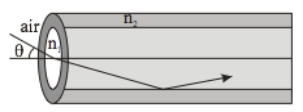 A fiber optic is made by cladding a thin fiber core of refractive index n1 = 1.45 with a material of refractive index n2 = 1.38. The numerical aperture of a fiber optic is defined as NA = nair sin θm, where θm is the maximum incident angle so that the light ray is totally internally reflected inside the fiber. The NA for the fiber is
A fiber optic is made by cladding a thin fiber core of refractive index n1 = 1.45 with a material of refractive index n2 = 1.38. The numerical aperture of a fiber optic is defined as NA = nair sin θm, where θm is the maximum incident angle so that the light ray is totally internally reflected inside the fiber. The NA for the fiber isA) 0.445.
B) 0.614.
C) 0.645.
D) 0.407.
E) 0.470.

Unlock Deck
Unlock for access to all 182 flashcards in this deck.
Unlock Deck
k this deck
70
A 60° prism has a refractive index of 1.64 for blue light and 1.61 for red light. Calculate the difference in the angle of incidence for the initial red and blue light ray that is refracted inside the prism and just undergoes total internal reflection at the opposite face of the prism.
A) 4.1°
B) 1.5°
C) 3.2°
D) 2.4°
E) 0.4°
A) 4.1°
B) 1.5°
C) 3.2°
D) 2.4°
E) 0.4°

Unlock Deck
Unlock for access to all 182 flashcards in this deck.
Unlock Deck
k this deck
71
In any wave motion, dependence of velocity on wavelength is called
A) polarization.
B) deviation.
C) dispersion.
D) diffraction.
E) scattering.
A) polarization.
B) deviation.
C) dispersion.
D) diffraction.
E) scattering.

Unlock Deck
Unlock for access to all 182 flashcards in this deck.
Unlock Deck
k this deck
72
Which of the following is not a phenomenon by which polarized light can be produced from unpolarized light?
A) absorption
B) reflection
C) birefringence
D) diffraction
E) scattering
A) absorption
B) reflection
C) birefringence
D) diffraction
E) scattering

Unlock Deck
Unlock for access to all 182 flashcards in this deck.
Unlock Deck
k this deck
73
The index of refraction of a sample of glass cannot be determined by measuring the
A) Brewster's angle.
B) critical angle.
C) angle of minimum deviation.
D) ratio of true to apparent depth.
E) angle of dispersion between red and violet light.
A) Brewster's angle.
B) critical angle.
C) angle of minimum deviation.
D) ratio of true to apparent depth.
E) angle of dispersion between red and violet light.

Unlock Deck
Unlock for access to all 182 flashcards in this deck.
Unlock Deck
k this deck
74
The dependence of the index of refraction on wavelength is called dispersion. A beam of light in air) containing red and blue light is incident at an angle of 35° on a glass plate that has an index of refraction of 1.64 for blue light and 1.61 for red light. By what percent does the speed of the red light exceed that of the blue light inside the glass, i.e., calculate vred)-vblue) ) * 100 / vred)?
A) 1.1%
B) 1.8%
C) 0.53%
D) The speed is the same for both colors.
E) 0.019%
A) 1.1%
B) 1.8%
C) 0.53%
D) The speed is the same for both colors.
E) 0.019%

Unlock Deck
Unlock for access to all 182 flashcards in this deck.
Unlock Deck
k this deck
75
Light known to be polarized in the horizontal direction is incident on a polarizing sheet. It is observed that only 15 percent of the intensity of the incident light is transmitted through the sheet. What angle does the transmission axis of the sheet make with the horizontal?
A) 8.6º
B) 21º
C) 23º
D) 67º
E) 81º
A) 8.6º
B) 21º
C) 23º
D) 67º
E) 81º

Unlock Deck
Unlock for access to all 182 flashcards in this deck.
Unlock Deck
k this deck
76
A 60° prism has a refractive index of 1.64 for blue light and 1.61 for red light. Calculate the difference in the angle of emergence from the opposite face of the prism for a beam of red light and a beam of blue light that are both incident at an angle of 600.
A) 0.4°
B) 0.0°
C) 1.3°
D) 3.9°
E) 2.7°
A) 0.4°
B) 0.0°
C) 1.3°
D) 3.9°
E) 2.7°

Unlock Deck
Unlock for access to all 182 flashcards in this deck.
Unlock Deck
k this deck
77
The dependence of the index of refraction on wavelength is called dispersion. A beam of light in air) containing red and blue light is incident at an angle of 35° on a glass plate that has an index of refraction of 1.64 for blue light and 1.61 for red light. Calculate the angle between the red and blue light inside the glass.
A) 1.3°
B) 0.40°
C) 0.56°
D) 0.74°
E) 0.13°
A) 1.3°
B) 0.40°
C) 0.56°
D) 0.74°
E) 0.13°

Unlock Deck
Unlock for access to all 182 flashcards in this deck.
Unlock Deck
k this deck
78
The index of refraction of water is approximately 1.33. The angle of incidence for maximum polarization by reflection from water is approximately
A) 57º.
B) 53º.
C) 45º.
D) 37º.
E) 33º.
A) 57º.
B) 53º.
C) 45º.
D) 37º.
E) 33º.

Unlock Deck
Unlock for access to all 182 flashcards in this deck.
Unlock Deck
k this deck
79
When taking a picture of a highly reflecting surface, it is desirable to use a polarizer in front of the camera to cut down on the "glare". Suppose you are taking a picture of a lake where the water is very still. The polarizing axis of the polarizer should ideally be oriented
A) horizontally.
B) vertically.
C) at 30°.
D) at 45°.
E) in any direction.
A) horizontally.
B) vertically.
C) at 30°.
D) at 45°.
E) in any direction.

Unlock Deck
Unlock for access to all 182 flashcards in this deck.
Unlock Deck
k this deck
80
Two polarizers have their transmission axes at an angle θ. Unpolarized light of intensity I is incident on the first polarizer. What is the intensity of the light transmitted by the second polarizer?
A) I cos2 θ
B) 0.5I cos2 θ
C) 0.25I cos2 θ
D) I cos θ
E) 0.25I cos θ
A) I cos2 θ
B) 0.5I cos2 θ
C) 0.25I cos2 θ
D) I cos θ
E) 0.25I cos θ

Unlock Deck
Unlock for access to all 182 flashcards in this deck.
Unlock Deck
k this deck



